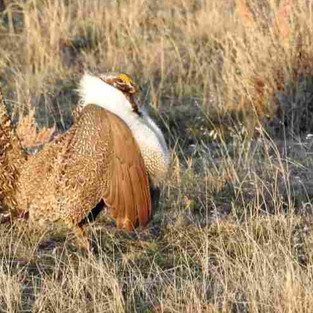I Lek Sage Grouse!
- Tina Toth

- May 3, 2020
- 4 min read
Updated: Oct 12, 2021
Check out this fun post about the charismatic Greater Sage-Grouse!

There must be a small part of every birder that has a thought that passes through their minds as they get up at 4:00 or 5:00 am (sometimes in a blizzard) to go out and watch what is one of the most unusual and exquisite rituals of the bird world: Am I really getting up this early to watch giant chickens dance? And the answer is yes, yes you are. And it is so worth it.
Greater Sage-Grouse gather from late March through early May each year for a ritual courtship. The place they meet is called a lek. Leks are typically in sagebrush country, often in areas with a clearing and more grass.

Much like an avian disco, the males and females hit the dance floor, with throngs of males puffing out their chests and displaying by filling air sacs and swishing their wings. Meanwhile, the females peck around seemingly uninterested in all of this show of force.
There are many lek protocols to follow for us human observers. Sage-grouse, which numbered around 16 million individuals pre-colonization, are down to a hopeful 200,000 individuals now. Intrusions and destruction of habitat, particularly fragmentation by roads and structures, make for problems for short-distance migrants and residents such as the grouse. Wyoming itself accounts for around 43 million acres of sagebrush habitat. For some perspective though, 95% of that land is thought to be within 1.5 miles of a road.

Rules at the Sage-Grouse Lek
Let’s go over some of these protocols, and why some of them can be “pros” for birds and humans alike.
1) Arrive well before dawn. This is where the magic happens. Sitting in your car, watching a beautiful Wyoming sunrise or a gently falling snow over the sagebrush sea, when suddenly out of the shadows you start to see movement here…there…and suddenly find yourself surrounded by grouse in full display mode. One minute you are looking at an ocean of sage, and next you realize some of that brush is alive. You cannot ask for a better setting.
2) Use your car as a blind or set up an actual blind the evening before the birds arrive.
3) Do not approach the lek on foot or in the vehicle.
4) Do not leave until the birds have finished their morning display. This makes for some even better shots than if you went charging over the prairie after them. Those in my area move around from the lek to other areas across the road, seemingly oblivious to the 2-3 cars sitting quietly watching them. They will park themselves right next to, in front of, and behind you, if you are lucky. (Note: some leks are well off the road, and staying put still applies - use long distances lenses and scopes for better looks.)

5) Turn off your car, be vewy vewy quiet, and leave "Fido" at home. All of this is necessary to avoid loud noises that might spook the birds. Besides, it’s a great time to enjoy the quiet contemplation of such a fabulous display.

Sage-Grouse Disco Fever
Now that we have some of the rules down, let’s enjoy the show!
Upon the lek proper, there can be one or two dozen dominant males displaying. Some leks are noted for having males that number into the triple digits! Males seem to give each other space fairly well. Almost like they are checking out the competition.

Occasionally there is a kerfuffle where one male gets shown to the sidelines. There may be some wing beating going on, but this doesn’t seem to result in any major damage, ego aside.
The most dominant and successful males stay to the center with some of their own dance space. As you move out from the center, you see smaller groups of males also strutting their stuff.
I've been told that sage grouse tails are highly individualized and can be used as identification.

Out along the perimeter, males also try to make their way into the lek proper. Sometimes they get chased out repeatedly by other males that have just managed to get into the circle. Again, damaged egos and a few missing tail feathers.

Meanwhile, well off the lek, you will find lesser males strutting away, practicing their technique on the few females that have wandered away from the main show. It is very reminiscent to me of elk behavior during the rut, where a few dominant males accumulate a herd of females and younger males circle the edges looking for a chance to pick up their own harem. Or at least a girlfriend, if only for a little while.
Note the size difference of the tail feathers between the male on the lek and another off.
After an hour or two, almost as suddenly as it began, the grouse disperse, dropping their displays, flying to areas out beyond the lek, and quite literally disappearing from the very brush they emerged from.

Magic.
For locations of leks and protocol in Wyoming, I highly recommend you check the link below:
Our thanks go out to Tina for writing this fun and educational story on enjoying Greater Sage-Grouse leks responsibly!







































Comments